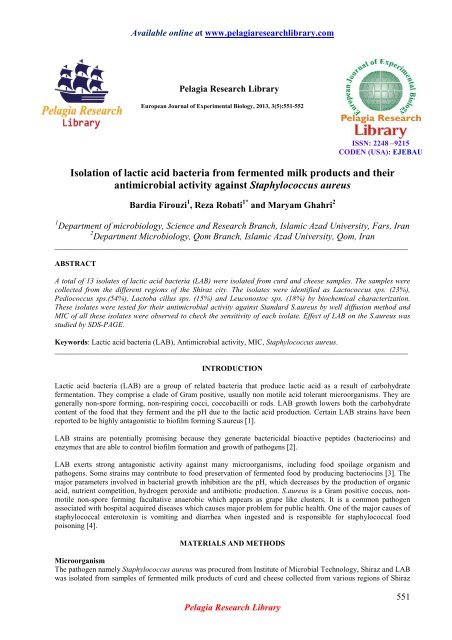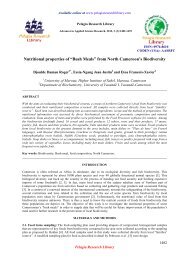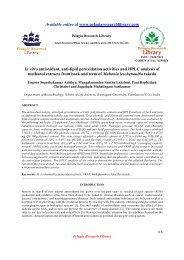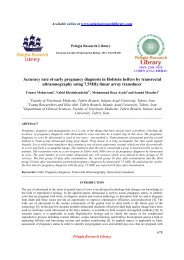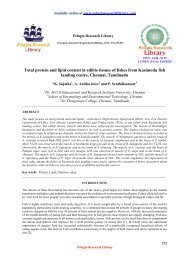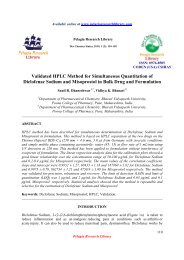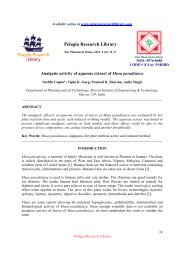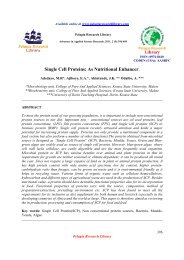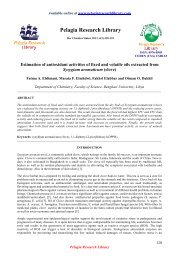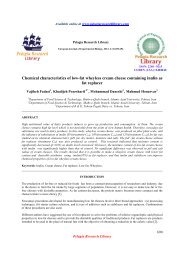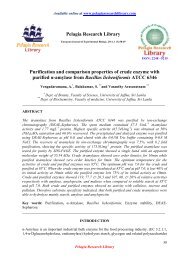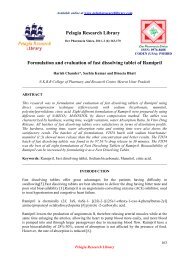Isolation of lactic acid bacteria from fermented milk products and ...
Isolation of lactic acid bacteria from fermented milk products and ...
Isolation of lactic acid bacteria from fermented milk products and ...
Create successful ePaper yourself
Turn your PDF publications into a flip-book with our unique Google optimized e-Paper software.
Available online at www.pelagiaresearchlibrary.com<br />
Pelagia Research Library<br />
European Journal <strong>of</strong> Experimental Biology, 2013, 3(5):551-552<br />
ISSN: 2248 –9215<br />
CODEN (USA): EJEBAU<br />
<strong>Isolation</strong> <strong>of</strong> <strong>lactic</strong> <strong>acid</strong> <strong>bacteria</strong> <strong>from</strong> <strong>fermented</strong> <strong>milk</strong> <strong>products</strong> <strong>and</strong> their<br />
antimicrobial activity against Staphylococcus aureus<br />
Bardia Firouzi 1 , Reza Robati 1* <strong>and</strong> Maryam Ghahri 2<br />
1 Department <strong>of</strong> microbiology, Science <strong>and</strong> Research Branch, Islamic Azad University, Fars, Iran<br />
2 Department Microbiology, Qom Branch, Islamic Azad University, Qom, Iran<br />
_____________________________________________________________________________________________<br />
ABSTRACT<br />
A total <strong>of</strong> 13 isolates <strong>of</strong> <strong>lactic</strong> <strong>acid</strong> <strong>bacteria</strong> (LAB) were isolated <strong>from</strong> curd <strong>and</strong> cheese samples. The samples were<br />
collected <strong>from</strong> the different regions <strong>of</strong> the Shiraz city. The isolates were identified as Lactococcus sps. (23%),<br />
Pediococcus sps.(54%), Lactoba cillus sps. (15%) <strong>and</strong> Leuconostoc sps. (18%) by biochemical characterization.<br />
These isolates were tested for their antimicrobial activity against St<strong>and</strong>ard S.aureus by well diffusion method <strong>and</strong><br />
MIC <strong>of</strong> all these isolates were observed to check the sensitivity <strong>of</strong> each isolate. Effect <strong>of</strong> LAB on the S.aureus was<br />
studied by SDS-PAGE.<br />
Keywords: Lactic <strong>acid</strong> <strong>bacteria</strong> (LAB), Antimicrobial activity, MIC, Staphylococcus aureus.<br />
_____________________________________________________________________________________________<br />
INTRODUCTION<br />
Lactic <strong>acid</strong> <strong>bacteria</strong> (LAB) are a group <strong>of</strong> related <strong>bacteria</strong> that produce <strong>lactic</strong> <strong>acid</strong> as a result <strong>of</strong> carbohydrate<br />
fermentation. They comprise a clade <strong>of</strong> Gram positive, usually non motile <strong>acid</strong> tolerant microorganisms. They are<br />
generally non-spore forming, non-respiring cocci, coccobacilli or rods. LAB growth lowers both the carbohydrate<br />
content <strong>of</strong> the food that they ferment <strong>and</strong> the pH due to the <strong>lactic</strong> <strong>acid</strong> production. Certain LAB strains have been<br />
reported to be highly antagonistic to bi<strong>of</strong>ilm forming S.aureus [1].<br />
LAB strains are potentially promising because they generate bactericidal bioactive peptides (bacteriocins) <strong>and</strong><br />
enzymes that are able to control bi<strong>of</strong>ilm formation <strong>and</strong> growth <strong>of</strong> pathogens [2].<br />
LAB exerts strong antagonistic activity against many microorganisms, including food spoilage organism <strong>and</strong><br />
pathogens. Some strains may contribute to food preservation <strong>of</strong> <strong>fermented</strong> food by producing bacteriocins [3]. The<br />
major parameters involved in <strong>bacteria</strong>l growth inhibition are the pH, which decreases by the production <strong>of</strong> organic<br />
<strong>acid</strong>, nutrient competition, hydrogen peroxide <strong>and</strong> antibiotic production. S.aureus is a Gram positive coccus, nonmotile<br />
non-spore forming facultative anaerobic which appears as grape like clusters. It is a common pathogen<br />
associated with hospital acquired diseases which causes major problem for public health. One <strong>of</strong> the major causes <strong>of</strong><br />
staphylococcal enterotoxin is vomiting <strong>and</strong> diarrhea when ingested <strong>and</strong> is responsible for staphylococcal food<br />
poisoning [4].<br />
MATERIALS AND METHODS<br />
Microorganism<br />
The pathogen namely Staphylococcus aureus was procured <strong>from</strong> Institute <strong>of</strong> Microbial Technology, Shiraz <strong>and</strong> LAB<br />
was isolated <strong>from</strong> samples <strong>of</strong> <strong>fermented</strong> <strong>milk</strong> <strong>products</strong> <strong>of</strong> curd <strong>and</strong> cheese collected <strong>from</strong> various regions <strong>of</strong> Shiraz<br />
Pelagia Research Library<br />
551
Reza Robati et al Euro. J. Exp. Bio., 2013, 3(5):551-552<br />
_____________________________________________________________________________<br />
city. Identification <strong>of</strong> Lactic <strong>acid</strong> <strong>bacteria</strong> MRS Agar <strong>and</strong> MRS broth were used for enumeration <strong>and</strong> culture <strong>of</strong><br />
Lactic <strong>acid</strong> <strong>bacteria</strong> at 37°C for 24 hrs. The cultures were identified by performing various morphological <strong>and</strong><br />
biochemical characterization. It includes Gram reaction, Spore formation, Glucose production, hot loop test <strong>and</strong><br />
Sugar fermentation test. After confirmation <strong>of</strong> LAB isolates, turbidity were matched with the McFarl<strong>and</strong> st<strong>and</strong>ard<br />
series. Out <strong>of</strong> 13 isolates, 6 isolates were having 15 × 108 CFU/ml <strong>and</strong> 7 isolates were having 12 × 108 CFU/ml.<br />
Determination <strong>of</strong> Antimicrobial Activity <strong>of</strong> LAB isolates against S.aureus<br />
The antimicrobial activity <strong>of</strong> isolated LAB S.aureus was performed by well-diffusion method[5]. S.aureus was<br />
incubated in BHI broth at 37° C at 24 hrs. 15ml <strong>of</strong> Muller Hinton Agar was prepared <strong>and</strong> 150µl <strong>of</strong> S.aureus culture<br />
having 6 × 108 CFU/ml was inoculated into it. Once solidified the plates, wells <strong>of</strong> 6mm diameter were made <strong>and</strong><br />
40µl <strong>of</strong> each concentration <strong>of</strong> LAB isolates were filled into well [6]. Then the plates were incubated at 37°C for 24<br />
hrs. And antimicrobial activity was determined by measuring the clear zone around the well [7].<br />
RESULTS AND DISCUSSION<br />
A total <strong>of</strong> 13 LAB isolates, 3 (23%) belonged to Lactococcus, 7 (54%) to Pediococcus, 2 (15%) to Lactobacillus, 1<br />
(8%) to Leuconostoc, which has shown in figure 4. The antimicrobial activity <strong>of</strong> LAB isolates at different dilutions<br />
was tested against S.aureus which has shown in figure 5 <strong>and</strong> figure 6. Out <strong>of</strong> 6 isolates <strong>of</strong> LAB having 15 × 108<br />
CFU/ml, S1 gave largest zone <strong>of</strong> inhibition followed by S13 (Pediococcus), S2 (Pediococcus) <strong>and</strong> S7 (Pediococcus)<br />
at 6 × 107 CFU/ml, while only 3 isolates S1(Lactococcus), S2 (Pediococcus) <strong>and</strong> S13 (Pediococcus) also gave<br />
inhibitory zones at 2 × 107CFU/ml <strong>and</strong> 0.66 × 107 CFU/ml. On the other h<strong>and</strong>, out <strong>of</strong> 7 LAB isolates having 12 ×<br />
108 CFU/ml, S5 (Leuconostoc) <strong>and</strong> S8 (Pediococcus) gave largest zone <strong>of</strong> inhibition at 4.8 × 107 CFU/ml. These<br />
zones are followed by S12 (Hom<strong>of</strong>ermentative Lactobacillus) only gave zone <strong>of</strong> inhibition at 0.53 × 107 CFU/ml.<br />
These zones are followed by S12 (Hom<strong>of</strong>ermentative Lactobacillus), S10 (Pediocoocus) S11 (Pediococcus) <strong>and</strong> S9<br />
(Pediocoocus).While S12 (Hom<strong>of</strong>ermentative Lactobacillus) only gave zone <strong>of</strong> inhibition at 0.53 × 107 CFU/ml.<br />
These results may be because <strong>of</strong> the wide spectrum <strong>of</strong> antimicrobial activities <strong>of</strong> LAB isolates which varies<br />
according to the serotype[6]. The results depicted that inhibition zones decreases as the concentration <strong>of</strong> LAB<br />
isolates. Out <strong>of</strong> the 13 isolates, S1 (Lactococcus), S2 (Pediococcus), S13 (Pediococcus) <strong>and</strong> S12 (Lactobacillus)<br />
gave lowest minimum inhibitory concentration <strong>of</strong> 0.66 × 107 CFU/ml <strong>and</strong> 0.53 × 107 CFU/ml. These 4 LAB<br />
isolates indicate that they are highly sensitive in inhibiting the growth <strong>of</strong> S.aureus even at a low concentration.<br />
REFERENCES<br />
[1] Ammor S, TauveronG, Dufour E,Chevallier I. Food control. 2006,17: 454-461.<br />
[2] Millette M, Luquet FM, Lacroix M. Lett. Appl. Microbiol. 2006, 44: 314-319.<br />
[3] Brinkten B, Minekns M, V<strong>and</strong>ervossen, JMBM, Leer RJ, Huis in’t Veld, JHJ. J. Appl. Microbiol. 1994, 77(2):<br />
140-148.<br />
[4] Nostro A, Cannatelli MA, Musolino AD, Procopio F, Alonzo V. Lett. Appl. Microbiol. 2002, 35: 181-184.<br />
[5] Al-Allaf MAH, Al-Rawi AMM, Al-Mola AT. Iraqi J. <strong>of</strong> Bact. Sci. 2009, 23(1): 115-117.<br />
[6] Savodogo A, Ouattara CAT, Bassole IHN, Traore AS. Pak. J. Nut. 2004, 3(3): 174-179.<br />
[7] DuToit M, Dicks LMT, Holzapfel, WH. Lett. Appl. Microbiol. 2001, 32: 199-204.<br />
Pelagia Research Library<br />
552


